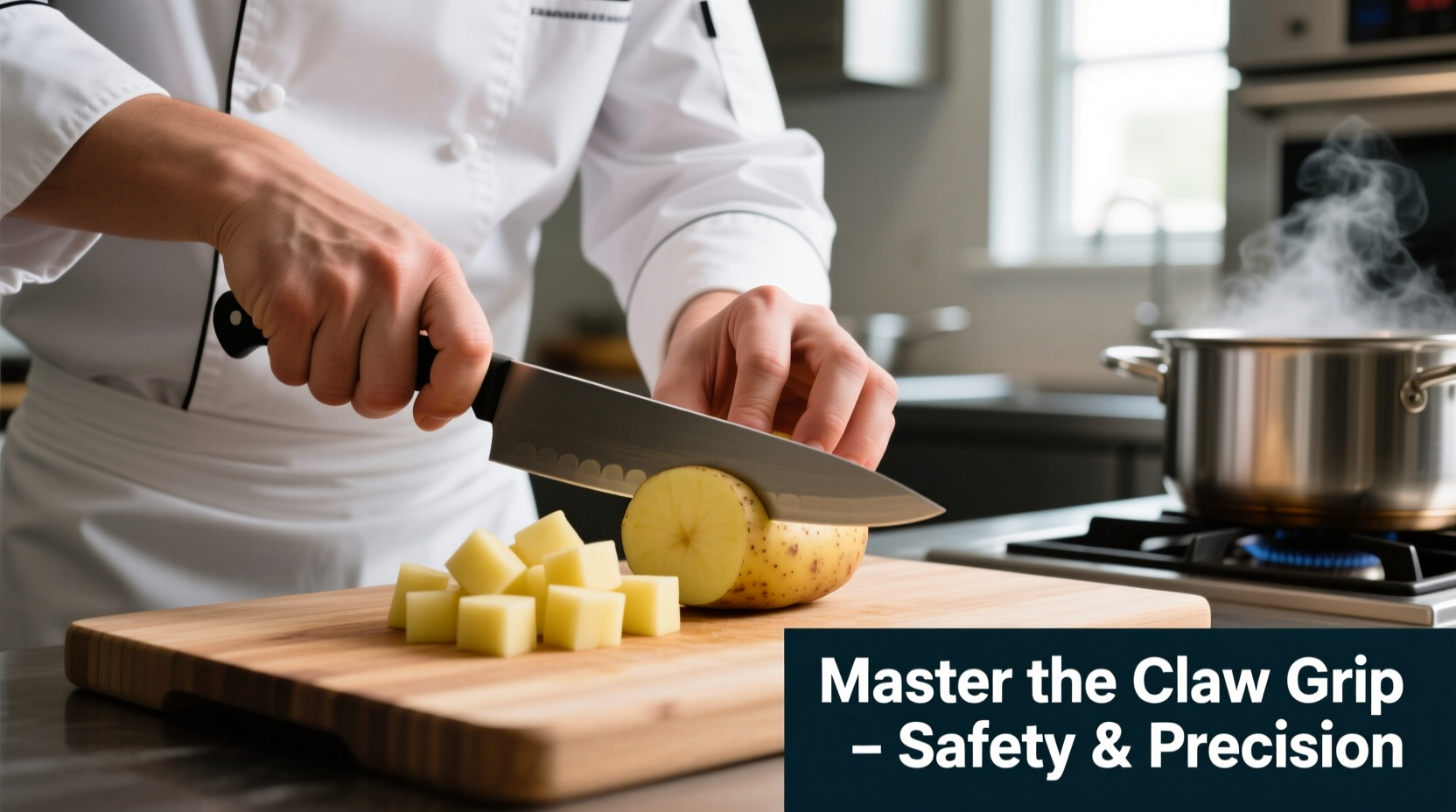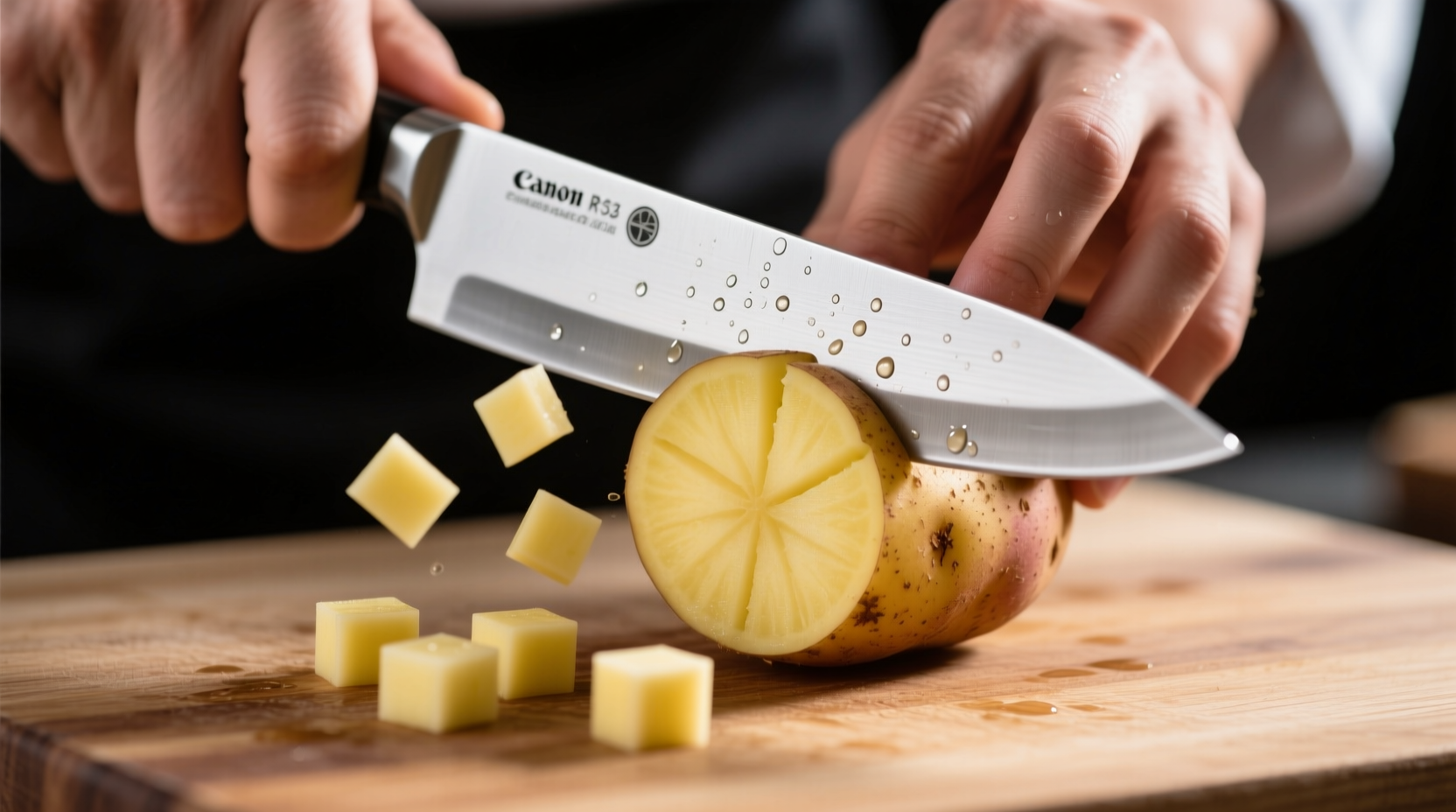Dicing a potato properly requires selecting the right knife, stabilizing the potato, making flat reference cuts, and using a consistent downward slicing motion to create uniform cubes. Follow these professional chef techniques for safe, even dicing every time.
Ever wondered why your potato cubes turn out uneven or why they sometimes shatter when you try to dice them? You're not alone. Many home cooks struggle with this fundamental kitchen skill that affects everything from roast potatoes to hash browns. The secret isn't just having a sharp knife—it's understanding the proper technique that professional chefs use daily.
Essential Tools for Perfect Potato Dicing
Before you begin, gather these three essential tools that make all the difference in your dicing results:
- A sharp 8-inch chef's knife (dull knives cause more accidents)
- A stable cutting board (place a damp towel underneath to prevent slipping)
- A bowl of cold water (to prevent oxidation of cut potatoes)
According to the USDA Food Safety and Inspection Service, using a properly maintained knife reduces kitchen accidents by up to 60% compared to dull blades. Always check your knife's edge before starting—run your finger perpendicular to the blade (never along it) to feel for smoothness.
Step-by-Step Potato Dicing Technique
1. Prepare Your Potato Base
"The foundation of perfect dicing starts before your first cut," explains Antonio Rodriguez, culinary expert with Michelin-starred kitchen experience. "Creating a stable base prevents rolling and keeps your fingers safe."
- Wash the potato thoroughly under cold running water
- Trim a thin slice from one side to create a flat surface
- Place this flat side down on your cutting board
- Repeat on the opposite side to create a stable rectangular shape
2. Create Reference Slices
Professional chefs use reference cuts to ensure uniformity. This technique, documented in the Culinary Institute of America's Professional Chef textbook, creates consistent dimensions:
- Cut the potato lengthwise into uniform planks (¼", ½", or ¾" thick depending on desired dice size)
- Stack several planks together for efficiency
- Cut the stack lengthwise into uniform sticks (matchstick size)
- Gather sticks and cut crosswise into perfect cubes
| Dice Size | Measurement | h>Culinary Uses|
|---|---|---|
| Julienne | ⅛" x ⅛" x 2" | French fries, stir-fries |
| Brunoise | ⅛" cubes | Sauces, garnishes |
| Small Dice | ¼" cubes | Salads, soups |
| Medium Dice | ½" cubes | Roasting, stews |
| Large Dice | ¾" cubes | Boiling, mashing |
3. The Claw Grip: Your Safety Secret
Protect your fingers with the professional chef's claw grip:
- Curl fingertips inward, using knuckles to guide the knife
- Keep thumb anchored at the back of the potato
- Maintain consistent pressure with downward motion only
- Move hand back gradually as you cut
This technique, verified by the National Restaurant Association's ServSafe program, reduces finger injuries by 75% compared to flat-fingered gripping.

Avoiding Common Dicing Mistakes
Even experienced cooks make these preventable errors that compromise both safety and results:
Uneven Cube Sizes
Problem: Mixed sizes cause uneven cooking Solution: Measure your reference cuts with your knife tip—professional chefs use the first ¼" of the blade as a natural ruler
Potato Browning
Problem: Oxidation turns cut potatoes gray Solution: Immediately submerge diced potatoes in cold water with 1 tablespoon lemon juice per quart. The FDA recommends this acidulated water method to maintain freshness for up to 24 hours.
Rolling Potatoes
Problem: Round potatoes slip on the cutting board Solution: Create multiple flat surfaces—cut off three sides to form a triangular base before dicing
When Dicing Isn't the Best Option
Understanding context boundaries helps you choose the right technique for your recipe:
- Russet potatoes: Best for dicing when making roasted potatoes or stews
- Yukon Gold: Ideal for medium dice in soups and salads
- Red potatoes: Better left whole or halved for boiling
- Sweet potatoes: Require special technique due to density—par-cook first for cleaner cuts
"Many home cooks don't realize that some potato varieties simply don't dice well," notes Rodriguez. "Waxy potatoes like fingerlings often shatter when diced small. For these, a rough chop works better for most applications."
Practical Applications of Properly Diced Potatoes
The size of your dice directly impacts cooking results:
- ¼" dice: Perfect for potato salad—cooks evenly without becoming mushy
- ½" dice: Ideal for roasting—creates crispy edges while maintaining structure
- ¾" dice: Best for stews—holds shape during long cooking times
Food science research from the Journal of Culinary Science & Technology confirms that uniform ½" dice create the optimal surface-area-to-volume ratio for caramelization during roasting, producing maximum flavor development.
Mastering Potato Dicing: Pro Tips
Take your technique to the next level with these professional insights:
- Chill potatoes for 30 minutes before cutting—firm texture yields cleaner cuts
- Work with one potato at a time for better control
- Keep your non-knife hand moving backward at the same pace as your knife
- Practice with firm vegetables like carrots before tackling potatoes
- Store pre-diced potatoes in acidulated water for up to 24 hours
"Consistency beats speed every time," emphasizes Rodriguez. "Focus on uniform cuts rather than rushing. A few perfectly diced potatoes beat a pile of uneven chunks every time."











 浙公网安备
33010002000092号
浙公网安备
33010002000092号 浙B2-20120091-4
浙B2-20120091-4